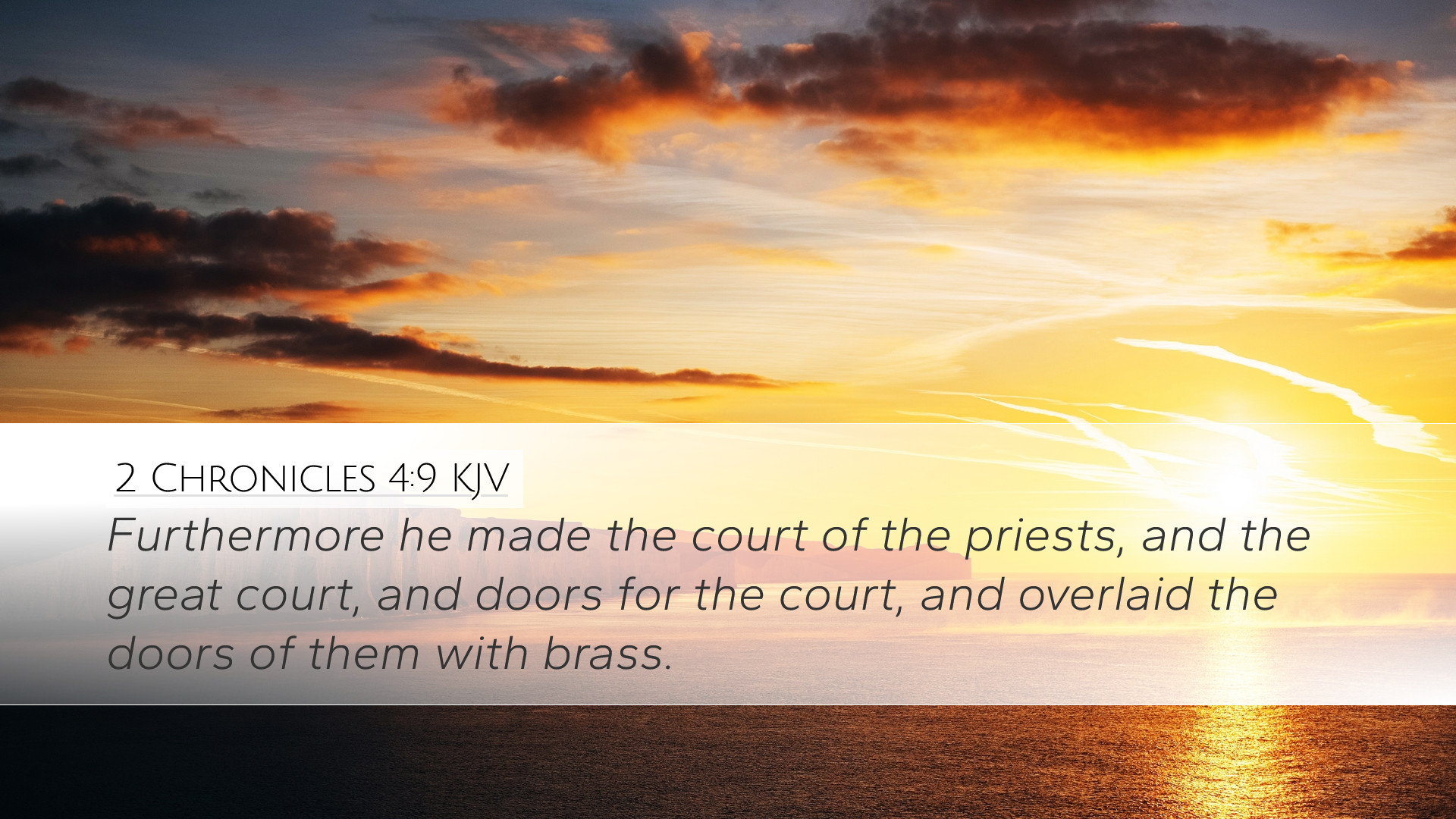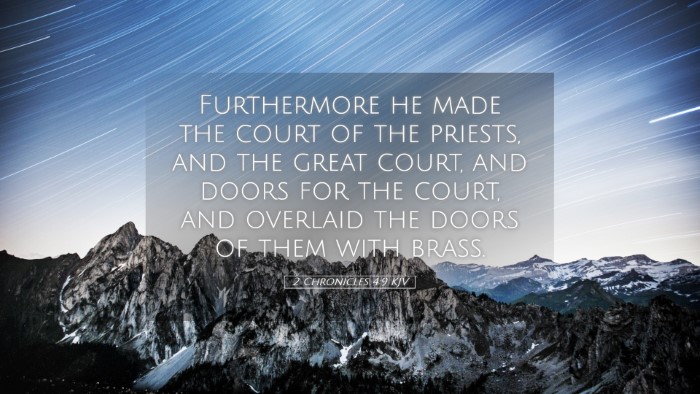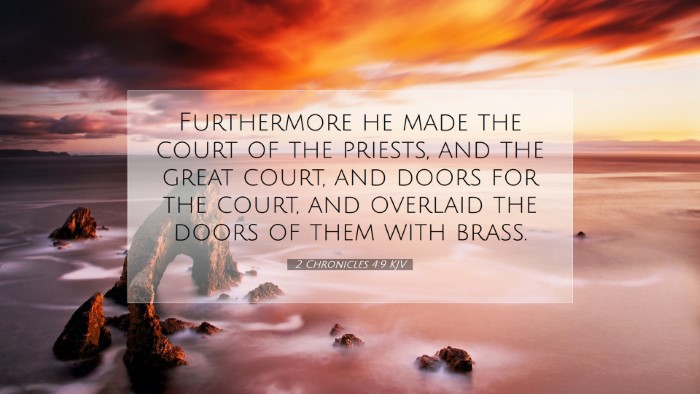Commentary on 2 Chronicles 4:9
Verse Text: "Furthermore he made the court of the priests, and the great brazen altar, and the vessels of the court."
Introduction
This verse is a part of the larger narrative concerning the construction of the temple in Jerusalem under King Solomon. In this chapter, the details focus on the preparations made for the temple service, and in particular, the arrangements made for the priesthood's functionality within this sacred space. Insights from public domain commentaries provide a deeper understanding of the significance of these actions.
Historical Context
The context of 2 Chronicles, like that of 1 Chronicles, emphasizes the Davidic lineage and the temple as the center of worship for Israel. King Solomon, the son of David, assumed the throne and undertook the monumental task of building the temple, aligning with God's promise to David regarding a dwelling place for His name. This verse delineates the specific structures that facilitated worship and sacrifice, marking a pivotal shift in Israel’s religious observance.
Interpretive Insights
The Court of the Priests
According to Matthew Henry, the court of the priests was a vital area where the priests could perform their duties. It was a place of reverent activity, separated from the laity. The establishment of this court signifies the separation of the sacred from the common and underscores the holiness required in approaching God.
The Great Brazen Altar
Albert Barnes emphasizes that the brazen altar represents the means of atonement and the principles of sacrifice that underpin the Mosaic covenant. This altar was the focal point of sacrificial worship, where sins were symbolically transferred to the offerings, pointing to the necessity of sacrifice for reconciliation with God. The construction of such an altar was divinely ordained in Exodus 27:1-8, signifying that Solomon was adhering faithfully to God's commands.
The Vessels of the Court
In regards to the vessels mentioned in this verse, Adam Clarke notes that these were instrumental for ritual purity and the performance of ceremonies. They included basins, pots, and other implements necessary for conducting sacrifice and offerings. Clarke observes that the meticulous preparation of these vessels reflects a profound respect for the holy requirements of worship.
Theological Reflections
This verse and its surrounding context offer rich theological underpinnings relevant for pastors, theologians, and students. The careful construction of the courts and altar reflects God's desire for order and holiness in worship. Each element plays a significant role in conveying deeper truths about access to God, sacrifice, and the physical manifestation of faith practices.
Access to God
The court of the priests illustrates how God provided a means for His chosen people to approach Him through intermediaries. In the New Testament context, this foreshadows the ultimate priesthood of Christ, who grants direct access to the Father (Hebrews 4:14-16). The structures symbolize a transitional phase in God’s plan, moving towards a point where humanity no longer needs intermediaries but finds complete redemption through Christ.
The Role of Sacrifice
The great brazen altar stands as a primary symbol of sacrifice—essential to both the Old Testament worship and the understanding of redemption. Sacrifices in the temple were anticipatory of the ultimate sacrifice of Jesus Christ, who became the Lamb of God to take away the sin of the world (John 1:29). Thus, in these Old Testament practices, we find threads that weave through to New Testament theology, enriching our comprehension of God’s redemptive plan.
Preparation and Holiness
The extensive preparations made in building the temple and its courtyards reflect the seriousness with which God’s holiness should be regarded in worship. It encourages contemporary believers to examine their own worship practices, ensuring that they honor God through their demeanor, preparation, and reverence in both communal and private settings. Such a commitment to holiness draws upon the biblical principle that God calls His people to be holy, as He is holy (1 Peter 1:15-16).
Practical Application
As educators, pastors, and scholars engage with this passage, there are notable practical applications to consider:
- Emphasis on Worship: Reinforcing the centrality of worship in the life of the church and the importance of preparing one's heart for worship.
- Teaching on Sacrifice: Drawing parallels between the sacrificial system of the Old Covenant and the sacrificial love of Christ.
- Holiness in Worship: Encouraging congregations to approach worship with a spirit of holiness and awe, recognizing the presence of God.
Conclusion
2 Chronicles 4:9 serves as a reminder of the foundational concepts of worship, sacrifice, and the reverence due to God. As readers reflect on these structures built by Solomon, a deeper appreciation for God's plan of redemption through Christ emerges. It invites an active engagement with both the historical and theological aspects of scripture, calling believers today to understand their own worship in light of the faithfulness of God across the ages.


